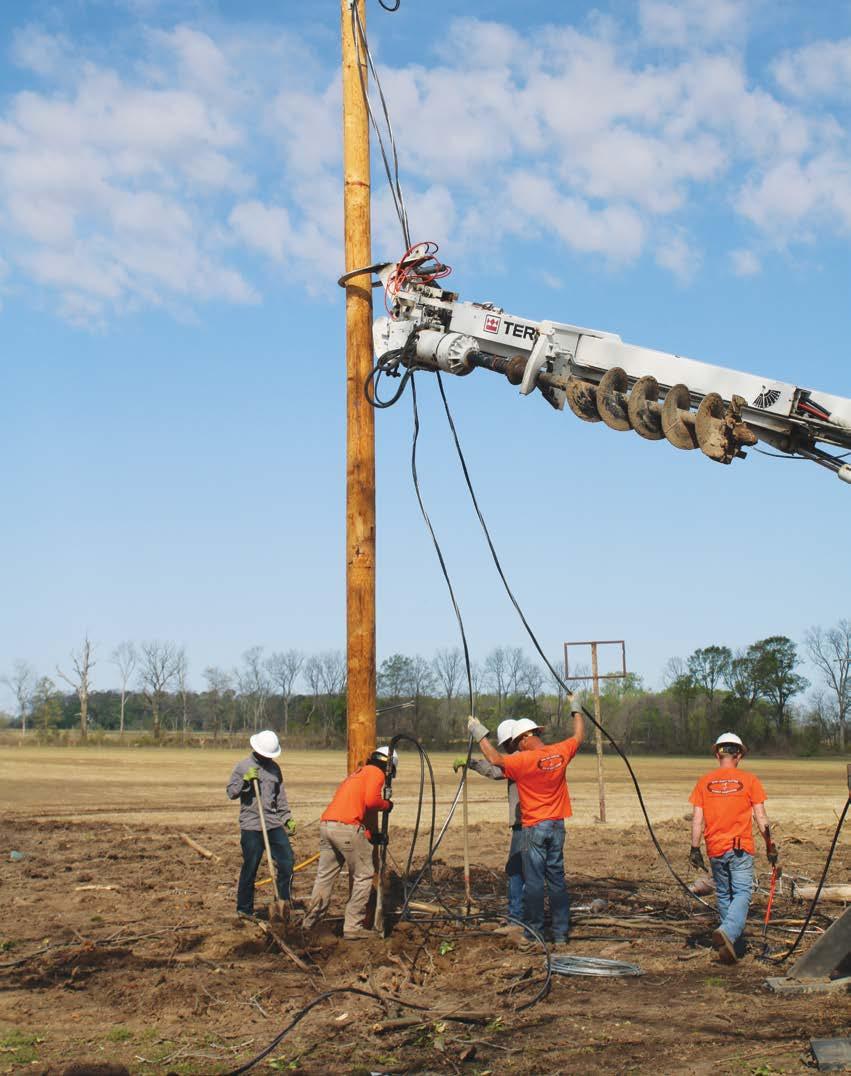EASY MOTHER’S DAY RECIPES










GIRLS GET DOWN TO BASS TACTICS INTO THE WILD

































EASY MOTHER’S DAY RECIPES










GIRLS GET DOWN TO BASS TACTICS INTO THE WILD
































An EF-3 tornado struck parts of rural Mississippi March 24 causing historic damage that communities are still sorting through as of this writing.
The towns of Rolling Fork, Silver City, and Amory were hit hard that night. There were close to 20 lives lost, homes and businesses that were wiped out, and of course, major power outages.
Those three communities are part of the service territories of Twin County Electric and Monroe County Electric.
Once we knew bad weather was headed our way, we activated our emergency plan including rolling out our co-op mutual aid strategy.


Cooperatives around the world operate according to the same set of core principles and values, adopted by the International Co-operative Alliance. Cooperatives trace the roots of these principles to the first modern cooperative founded in Rochdale, England in 1844. These principles are a key reason that America’s electric cooperatives operate di erently from other electric utilities, putting the needs of their members first.
When disaster strikes, it’s the sixth cooperative principle that becomes key to power restoration — Cooperation Among Cooperatives.
Co-ops work together to improve services, bolster local economies, and deal more e ectively with social and community needs. They also assist each other during times of crisis.
Our cover story this month is about how co-op mutual aid is our most vital tool in safe and timely power restoration in the aftermath of disaster.

We hope you enjoy the May issue.
Mississippi to me?
It’s a thousand memories, of the beaches, and the breeze, and the lapping of the Gulf on my knobby-kid knees.

Mississippi to me?
by Michael Callahan Executive Vice President/CEO Electric Cooperatives of Mississippi






It’s family folk, now departed, on the seawall, and the harbor, catching bounty from the waters; trout and shrimp, and crab and oysters.
Mississippi to me?
It’s the place that I am known. Where my soul can freely roam, where my heart and I belong.
Mississippi is my home.
by Penny Cox Caldwell, a resident of the Hancock County coast, and a member of Coast ElectricThe Official Publication of the Electric Cooperatives of Mississippi
OFFICERS
Randy Carroll - President
Ron Barnes - First Vice President
Tim Perkins - Second Vice President
Brian Hughey - Secretary/Treasurer
Michael Callahan - Executive Vice President/CEO
EDITORIAL STAFF
Lydia Walters - VP, Communications
Steven Ward - Editor
Chad Calcote - Creative Director
Kevin Wood - Graphic Designer
Alan Burnitt - Graphic Designer

Courtney Warren - Graphic Designer
Chris Alexander - Member Services Coordinator
Steve Temple - Social Media Director
Mickey Jones - Administrative Assistant

EDITORIAL OFFICE & ADVERTISING
601-605-8600
Acceptance of advertising by Today in Mississippi does not imply endorsement of the advertised product or services by the publisher or Mississippi’s electric power associations. Product satisfaction and delivery responsibility lie solely with the advertiser.
• National advertising representative:
American MainStreet Publications, 800-626-1181
Circulation of this issue: 482,918
Non-member subscription price: $9.50 per year.
Today in Mississippi (ISSN 1052-2433) is published 12 times a year by Electric Cooperatives of Mississippi Inc., P.O. Box 3300, Ridgeland, MS 39158-3300, or 665 Highland Colony Parkway, Ridgeland, MS 39157. Phone 601-605-8600. Periodical postage paid at Ridgeland, MS, and additional office. The publisher (and/or its agent) reserves the right to refuse or edit all advertising.

POSTMASTER: Send all UAA to CFS. (See DMM 507.1.5.2)
NON-POSTAL AND MILITARY FACILITIES: send address corrections to: Today in Mississippi, P.O. Box 3300, Ridgeland, MS 39158-3300
www.facebook.com/TodayinMississippi
www.todayinmississippi.com
Two days after an EF-3 tornado hit the Rolling Fork area on March 24, members of a Twin County Electric work crew replace a power pole. Photo by Kevin Wood.
Central Electric Power Association, Coahoma Electric Power Association, Coast Electric Power Association, Delta Electric Power Association, Dixie Electric Power Association, East Mississippi Electric Power Association, 4-County Electric Power Association, Magnolia Electric Power, Monroe County Electric Power Association, Natchez Trace Electric Power Association, North East Mississippi Electric Power Association, Northcentral Electric Cooperative, Pearl River Valley Electric Power Association, Pontotoc Electric Power Association, Singing River Electric, Southern Pine Electric, Southwest Electric, Tippah Electric Power Association, Twin County Electric Power Association, and Yazoo Valley Electric Power Association.
The R.D. Morrow, Sr. Generating Station, located near Purvis, achieved commercial operation on March 16 as an advanced-class natural gas-fired plant capable of generating 572 MW of electricity.

The new plant operates on the site of the cooperative’s original 1978 coal facility. In June 2018, the Cooperative Energy Board of Directors announced a five-year plan to convert the plant from coal to natural gas due to improved e ciency and economic factors. As a not-for-profit, member-owned electric utility, responsibility, reliability, and a ordability were deciding factors for the project. Now complete, the plant generates more electricity more economically and provides the operational flexibility necessary to balance the increase in renewable energy sources across the country.
The Morrow Repower Project also set a new standard for employee retention. Whereas many plant conversions result in sta reductions, all Plant Morrow employees were retained throughout the project to assist with demolition, construction, and plant conversion activities, yielding a positive local economic impact and overall project savings.
“Plant Morrow represents forward-thinking energy solutions for our distribution Members at a competitive price,” said Cooperative Energy’s Senior Vice President of Power Generation Mark Smith. “Equally as important, the new Plant Morrow represents years of grit and determination by many Cooperative Energy employees for the benefit of our 11 member systems and those they serve across the state.”
Cooperative Energy employees collectively invested nearly 300,000 work hours in the Morrow Repower Project with a nearly perfect safety record, yielding more than $12 million in project savings.
CoBank, a cooperative bank serving the electric industry, agribusinesses, rural infrastructure providers and Farm Credit associations throughout the United States, has contributed $250,000 in support of NRECA International’s rural electrification projects in developing countries. This is the 12th consecutive year CoBank has donated to NRECA International, totaling $2.5 million in collective contributions.

NRECA International has helped more than 160 million people worldwide, improving their quality of life by providing access to safe, reliable, and a ordable electricity.


This year’s donation will be used to continue the support for electrification projects in Guatemala. For over a decade, electric cooperatives across country have joined NRECA International to bring power to more than 8,000 Guatemalans – significantly brightening their futures.
When the Guatemalan project initially began in 1987, just 45% of the homes in Guatemala had electric service, with only 10% of rural areas receiving service. Today, Guatemala has electricity service for 92% of all households and businesses — however there are scattered housing clusters and small villages in the more remote, mountainous villages throughout Guatemala that still need electricity.
Gene Rodrigues, assistant secretary of energy for electricity, said he shares the National Rural Electric Cooperative Association’s goal of ensuring that the electric grid “remains reliable, resilient and a ordable for all Americans.” The importance of grid reliability was the main message that co-op leaders took to Capitol Hill and federal agencies during April’s NRECA Legislative Conference in Washington, D.C.
“We are all in agreement with every single one of you in this room that reliability is the foundation of everything we want to do,” he said.
Unfortunately, the American people and many of their elected o cials “take it for granted” that the lights will always come on when they flip the switch, Rodrigues said.
“That’s a problem,” he said, urging co-op leaders to “advocate, educate and collaborate” to sound the alarm about the potential risks to reliability.
“If it’s taken for granted, then we won’t have the champions we need to keep electricity reliable and a ordable over time. … Make sure they understand the absolute necessity of investing in a 21st century power grid for the American people.”
DOE o cial: ‘Reliability is the foundation’





 by Shaun Robert Broderick
by Shaun Robert Broderick

For example, I’ve never heard anyone having problems with hydrangeas popping up in the landscape unexpectedly. Nor have I heard someone call a hydrangea growing in the wrong spot a weed. Instead, I think of weeds as nuisance plants that have the capacity to outcompete desirable plants in the landscape or garden.



Unfortunately, we have introduced many plants in the U.S. that have become weedy problems. Kudzu, cogon grass, tallow tree, Chinese privet, and Chinese and Japanese wisteria are just a few examples.
But one plant that shows up on nearly every invasive species list is Lonicera japonica, commonly known as Japanese honeysuckle. This vining plant was first introduced in the U.S. in 1806 at Long Island, New York. Since its introduction, it has taken o in the eastern U.S.







It is one of the most fragrant flowers in the landscape, and it blooms prolifically. Birds love its red berries and help disperse the seeds. From there, the seeds quickly grow to overtake other plants in the forest. Several states have outlawed Japanese honeysuckle sales, indicating how destructive and invasive this plant has become.
If you find Japanese honeysuckle on your property, it would be prudent to remove it, but it requires some e ort to get them out of the garden.

I had some growing along our fence line that I was able to remove over the course of a couple of years. I pruned the plants to the ground and dug out the shoots that reemerged over time. Herbicides can be e ective, but the plants I was trying to remove were next to other plants that I did not want to risk damaging. Once you remove Japanese honeysuckles, there are fantastic — and in my opinion, even more beautiful — noninvasive alternatives.

Weeds are often defined as being any plant out of place, but that definition never sat well with me. This simplistic definition underemphasizes the aggressiveness of plants that misbehave in the garden.
One of my favorite vining plants is the native coral honeysuckle, Lonicera sempervirens. These vines have trumpet-shaped, red-orange flowers that emerge in early spring. Hummingbirds love them.

Their leaves are often a powdery, bluish-green, while others are glossy green. These vines are usually evergreen in mild winters. In the fall, they often develop small, red berries that birds love.
Native coral honeysuckle also tolerates a wide range of soil types and sun exposure. Ours flower and grow very well at the Mississippi State University Truck Crops Branch Experiment Station in Crystal Springs despite the heavy shade of oak trees. These plants are also easy to grow with little to no disease and insect problems.
In full sun, flowering is especially heavy.
Coral honeysuckle is very versatile in the landscape. It can be grown on structures such as arbors or along fences. This can create eye-catching hardscape-softscape combinations in areas needing extra height. And unlike some vining plants that get out of hand, you can prune coral honeysuckle to keep it a manageable size.
Perhaps the only downside is their lack of the iconic honeysuckle fragrance.
The native coral honeysuckle emerges in early spring often develops small, red berries that birds love in the fall. It tolerates a wide range of soil types and sun exposure. (Photo by MSU Extension/Shaun Broderick)
Coral honeysuckle is very versatile in the landscape. It can be grown on structures such as arbors or along fences. This can create eye-catching hardscape-softscape combinations in areas needing extra height.
If you miss the fragrance of Japanese honeysuckle, a good alternative is the woodbine honeysuckle, Lonicera periclymenum. This selection is native to Europe but does not appear on any invasive species list. Several cultivars are available. Scentsation and Graham Thomas have flowers that look very similar to Japanese honeysuckle and o er good fragrance. If you have a spot needing a vine, give these alternatives a try.
Shaun Robert Broderick is a Mississippi State University Extension Service ornamental horticulturist and Southern Gardening guest columnist.
Several cultivars of the woodbine honeysuckle are available, such as this Scentsation, that are similar to Japanese honeysuckle and o er good fragrance. (Submitted photo/Spring Meadow Nursery)









Like in many other sports, most professional anglers take years to reach the top of their profession. However, two young ladies fishing their first year together showed others how to do it.
Competing in the Beaumont, Miss.-based Bass Tactix youth fishing league, Lillie Beach and Karlee Ann Harveston earned top honors in the junior high division of the tour. They placed in the top 10 during the 2022 Bass Tactics national championship. During the 2022-23 season, they became the best junior high bass fishing team in Mississippi and not just the top women’s team, but the best overall team for both high school and junior high students.
mean to us, but it feels good to beat them. They don’t like to get beat by girls.”
“We feel really good about our fishing,” echoed Karlee Ann, a 12-year-old who will begin 8th grade at the same school in the fall.
When Karlee Ann was young, we would use minnows to catch crappie, as time progressed, she started doing some bass fishing.



“The boys teams give us a little bit of trouble,” commented Lillie, a 13-year-old who will enter 9th grade at Adams County Christian School in Natchez in the fall. “Some of them can be



At an early age, both young ladies began fishing with their fathers, David Beach and Lew Harveston, both from Natchez. Attending the same school, the girls knew each other, but not very well.
“Lillie was my little shadow,” David recalled. “Wherever I went, she went. I remember having her in the boat with a little playpen as a cover because it was too hot for her to be in the sun all day. She really took to fishing. As she got older, she stuck by my side for hunting and fishing. She had a lot more patience and sportsmanship than her brothers did.”
The young ladies became fishing partners by chance. Neither of their partners wanted to fish one event, so the girls teamed together. Although the girls will attend the same school in the fall, because Lillie will be a 9th grader, she moves up to the high school division. Karlee Ann will need to find a new partner to fish in the junior high division.
“When Karlee Ann was young, we would use minnows to catch crappie,” Lew said. “As time progressed, she started doing some bass fishing. In the past two years, she showed a lot of interest in getting into the school fishing program and getting on the school team. She has picked up bass fishing very well and has given it all she can give. I’m proud to see what they both do. It’s been amazing to watch them. They stuck together and work great as a team.”



A Christian-based, non-profit organization, Bass Tactix conducts youth and adult fishing tournaments throughout the South. Each youth team includes an adult coach, usually a parent, who accompanies the competitors. The adult coach drives the tow vehicle and operates the outboard motor on the boat. The youngsters must decide how and where they want to fish.
by John N. Felsher









John N. Felsher is a professional freelance writer, broadcaster, photographer, and editor who lives in Alabama. An avid sportsman, he’s written more than 3,300 articles for more than 170 different magazines on a wide variety of outdoors topics. Contact him at j.felsher@hotmail.com.



















 by Steven Ward
by Steven Ward
There are approximately 250 trained volunteers around the state spreading the gospel of conservation, natural resources, and environmental awareness.

How these volunteers came to provide that education to their communities is the story of Mississippi State University’s Extension Service’s Master Naturalist program.



The program, which is free, gives adults an opportunity to learn more about Mississippi fish, wildlife, and ecosystems. In return, the volunteers provide outreach and service education to their communities.
“There was an identified need to expand the educational capabilities of MSU Extension by the dissemination of natural resource management information to people in our communities,” said Adam T. Rohnke, state program co-leader and Central Mississippi program coordinator of the master naturalist program.




Rohnke said the program formally began in 2008 and was mostly focused then on the Gulf Coast. Today, the program is active in the Jackson area and the on the coast.

“On average, we graduate 35 to 50 participants combined annually from both locations. We intentionally keep the class size to 20 or less most years to improve the overall experience,” Rohnke said.


The primary program provides training and field experiences across various topics including ecology, natural resource management, paleontology, soils, water, wetlands, as well as the study of wildlife — birds, mammals, reptiles and amphibians, insects, and more.
Master naturalists also learn how to conduct basic research on a conservation issue and present a group project at the end of the program, Rohnke said.
Some examples of events the trained volunteers have produced include the Pearl River Clean Sweep that involves more than a 1,000 people across the Pearl River watershed in Mississippi and Louisiana removing thousands of pounds of trash from the waterway. That event was founded by Abby Braman, a graduate of the program. The Snappy Sync Firefly Soiree and Tours hosted by the Craftsman Guild of Mississippi in Ridgeland every spring involves master naturalists giving tours to hundreds of visitors to view and learn about synchronous fireflies. This program was founded by master naturalist Claire Graves.
Many other volunteers contribute to established programs such as Mississippi Museum of Natural Science educational events and participate in citizen science projects such as the Jackson Metro Urban Wildlife Project and the Mississippi Coastal Cleanup Program, where master naturalists actively participate in the collection of and help analyze data which directly contributes to peer-reviewed science.
When asked about one of his favorite parts of the program, Rohnke said he loves the “ah ha” moments that occur.
“We spend a day in the upper Pearl River learning about water and fisheries by being in the river for multiple hours. One year it began to pour — I mean Forrest Gump, Vietnam scene kind of rain — and all the participants started o hunching over to stay dry,” he said.

“But when we all finally realized it wasn’t going to stop, they embraced it and I got to watch adults ranging from age 18 to folks in their mid-70s completely soaked and loving every minute of it. I’ll never forget one older participant who said ‘I haven’t played in the rain since I was 11. What a refreshing and life changing moment this is. Thank you for doing this and making us brave the weather!’ I’ll never forget that moment and I can honestly say those 15 people from all walks of life, professions, races, generations, political a liations, and beliefs became one after that day in the rain.”







Register for a basic course on the Gulf Coast or in central Mississippi. Complete a 40-hour course that includes class and field instruction. Complete eight hours of advanced training annually. Complete 40 hours of volunteer service annually.

For more information, visit masternaturalist.extension.msstate.edu



I’ll never forget that moment and I can honestly say those 15 people from all walks of life, professions, races, generations, political a liations, and beliefs became one after that day in the rain.


This is your chance to get 100 mint US postage stamps for just $1. You save $39. Plus you’ll enjoy FREE shipping and guaranteed delivery.
Hard to find and worth $40 at our regular prices, this sought-after collection of mintfresh US stamps is a real value.
Hurry – older American stamps are growing scarcer each day. They’re very popular with collectors. These stamps will never be issued again and supplies are vanishing.

If you’d like to own this special collection of 100 mint US postage stamps for just $1, return the order form with your payment or credit card information. Plus shipping and guaranteed delivery are FREE! Place your order right away.
Strict limit of one collection. Your satisfaction is guaranteed. Send today and you’ll also get the chance to examine other desirable collections of historic US postage stamps.











❏ Yes! Send my 100 mint U.S. Postage Stamps for just $1. Satisfaction guaranteed. Strict limit of one collection at this special price. FREE shipping and guaranteed delivery. Quick order at MysticAd.com/OC25H
✔



























Culotta Insurance & Investments
Culotta Insurance & Investments



Serving Miss-Lou STATEWIDE Since 1992
Serving Miss-Lou STATEWIDE Since 1992
Serving Miss-Lou STATEWIDE Since 1992
Serving Miss-Lou STATEWIDE Since 1992
Serving Miss-Lou STATEWIDE Since 1992
1-844-AGENT4U
1-844-AGENT4U
1-844-AGENT4U
1-844-AGENT4U
1-844-AGENT4U
FIXED INDEXED ANNUITIES
FIXED INDEXED ANNUITIES
1-844-AGENT4U
FIXED INDEXED ANNUITIES
FIXED INDEXED ANNUITIES
FIXED INDEXED ANNUITIES
FIXED INDEXED ANNUITIES
MORE GAINS • NO LOSSES • SAFETY
MORE GAINS • NO LOSSES • SAFETY
MORE GAINS • NO LOSSES • SAFETY
MORE GAINS • NO LOSSES • SAFETY
MORE GAINS • NO LOSSES • SAFETY
MORE GAINS • NO LOSSES • SAFETY

Up to 11% IMMEDIATE INTEREST BONUS on DEPOSITS
Up to 11% IMMEDIATE INTEREST BONUS on DEPOSITS
Up to 11% IMMEDIATE INTEREST BONUS on DEPOSITS
Up to 11% IMMEDIATE INTEREST BONUS on DEPOSITS
Up to 11% IMMEDIATE INTEREST BONUS on DEPOSITS

ROLLOVER CD OR 401K TODAY!
Up to
ROLLOVER CD OR 401K TODAY!
ROLLOVER CD OR 401K TODAY!
ROLLOVER CD OR 401K TODAY!
ROLLOVER CD OR 401K TODAY!

FINANCIAL FREEDOM
FINANCIAL FREEDOM
Proud Partner of the New Orleans Pelicans
Proud Partner of the New Orleans Pelicans
Proud Partner of the New Orleans Pelicans
Proud Partner of the New Orleans Pelicans
Proud Partner of the New Orleans Pelicans
SAFE RETIREMENT STRATEGIES, MEDICARE SUPPS, LONG-TERM CARE, MEDICAL & LIFE
SAFE RETIREMENT STRATEGIES, MEDICARE SUPPS, LONG-TERM CARE, MEDICAL & LIFE
SAFE RETIREMENT STRATEGIES, MEDICARE SUPPS, LONG-TERM CARE, MEDICAL & LIFE
SAFE RETIREMENT STRATEGIES, MEDICARE SUPPS, LONG-TERM CARE, MEDICAL & LIFE
SAFE RETIREMENT STRATEGIES, MEDICARE SUPPS, LONG-TERM CARE, MEDICAL & LIFE





On May 17, Pearl River Valley Electric will celebrate its 85th anniversary. And while a lot has happened in eight and a half decades, we are still the same cooperative built on the hard work of area residents in 1938. It’s di cult to imagine that the men and women who founded Pearl River Valley Electric understood the enormous impact their actions would have on our communities. During that time, our state was in a socioeconomic crisis. In large cities and towns, residents benefited from electricity, whereas Mississippians, living in the country, toiled away as previous generations had without modern conveniences. For example, rural families relied on wood ranges and washboards to do their cooking and cleaning, and after school, children did their homework by candlelight or by the dim light of a kerosene lantern. Conversely, in cities, residents enjoyed refrigeration, electric ranges, and children studied under the glow of modern lightbulbs. It was as if two completely di erent worlds existed.



Across the country, nine out of 10 homes were without electric service, and this lack of availability kept rural areas tied to agriculture and inhibited them from diversifying into large manufacturing. Because of this disparity, President Franklin Roosevelt signed into legislation the Rural Electrification Act in 1935. This move allowed rural communities to start electric cooperatives, like Pearl River Valley Electric. Almost immediately men and women gathered to come up with a plan to energize thousands of miles of electrical lines for their neighbors. This was not an easy challenge, since Pearl River Valley Electric’s service area included thousands of rural homes and farms without power.
In order to get the work started, on one spring day in May 1938, a large number of rural residents from Marion, Lamar, and Je erson Davis counties met in Columbia to come up with a plan to electrify local farms and homes. On May 17, 1938, Pearl River Valley Electric Power Association became a legal corporation. The cooperative appointed five directors, who were given the task of adopting bylaws and acting upon applications for membership. Quickly, by the end of June, 228 members were already electrified. The cost for membership was $5.00, the same as it is now.

Over the next 20 years, PRVEPA grew dramatically. In 1950, the association boasted nearly 9,000 members and 2,500 miles of line. By 1960 PRVEPA had just over 10,300 members and by 1970, 13,000. Now, 85 years later, we serve over 52,000 homes and businesses and maintain over 6,000 miles of power lines.
















We owe a lot of gratitude to those early PRVEPA founders, who worked long hours to develop an electric system that is still in use today. The best way to honor their sacrifices is to carry on their handiwork by working to improve the lives of our members. That is why we are working so hard to bring fiber internet service to our service territory. It’s often said that the ideals of the past are “old fashioned,” but our current employees and Board of Directors strive to meet the same high standards our early employees set 85 years ago.









Pearl River Valley Electric’s distribution system has grown significantly over the past 85 years to meet the needs of our members. We now have more than 6,000 miles of power lines across our 12-county service area. Maintaining clear rights-of-way (ROW) along those lines is vital to the association’s ability to provide reliable service. It is also necessary to maintain a proper distance between trees and power lines to ensure public safety.

We want members to understand that maintaining ROW is not an inconvenience, it’s a necessity. Controlling vegetation within the ROW floor assures safe access for employees when they are troubleshooting outages and repairing downed power lines. The overall result of ROW maintenance is quicker restoration of outages during storms.



Clearing brush and other low-growing vegetation is accomplished by a combination of bush-hogging and herbicide application. We use o -the-shelf, non-restrictive herbicides because they are e ective, economical, and environmentally friendly. They are not harmful to humans, pets or livestock. Managing vegetation in this way also allows native grasses and wildflowers to grow, thereby improving the aesthetics and wildlife habitat along the ROW.
For a more detailed map of this year’s ROW spraying, please visit the help center at www.PRVEPA.com and click the “Technical Services” box.
Also, if you have any questions about our ROW maintenance program, please feel free to call any of our o ces. Thank you for your understanding and cooperation.
Right-of-way maintenance is underway in your area
March marked PearlComm Fiber’s one year anniversary since connecting its first customer, Shirley Pittman in Foxworth. Now, 14 months later, a lot of work, including infrastructure upgrades and personnel hiring, has been implemented to improve the fiber internet experience for customers. Right now, contractors for PearlComm are working long hours, including weekends, to reach more PRVEPA members as quickly as possible. There are currently over 60 crews working on fiber builds, drop constructions, splicing, and in-home installations.




Since last year, PearlComm Fiber’s service area has increased quickly as they have opened areas around Columbia, Foxworth, Maxie, and Wiggins for internet service. In total, over 5,000 PRVEPA members have become customers of PearlComm Fiber. PearlComm is moving so quickly, that they expect to reach over 8,000 customers by the end of the year.

There is much excitement surrounding PearlComm’s build, and updates can be found on their website, www.pearlcommfiber.net. The map that is included with this article is intended to be a tentative schedule only.

Remember, if you have not already pre-registered at pearlcommfiber. net, we encourage you to do so. Pre-registration is the easiest way to get notifications and service updates sent directly to your email when internet becomes available in your area; but pre-registration does not automatically subscribe you to service.





 Powered by Pearl River Valley Electric
Powered by Pearl River Valley Electric
MONDAY, MAY 29
Pearl River Valley Electric honors those who courageously gave their lives.
All Pearl River Valley Electric o ces will be closed in observance of Memorial Day.






Dispatchers will be available. Report outages by calling 855-2PRVEPA.









Aug. 11, 2023
Pearl River Valley Electric is on social media. Keep up to date with PRVEPA news and receive information on outages.

Simply search for @MyPRVEPA on Facebook and Twitter to follow us.
Applications are available at PRVEPA o ces and at www.prvepa.com. Completed applications must be postmarked or emailed by Aug. 11.
Scholarship recipients must be a PRVEPA member, spouse, or child of a member participating in the Round Up program.

Recipients must be full time (12 hours or more per semester) freshmen students enrolled in academic or career-technical programs.
Scholarship funds will be credited to each student’s college account — no checks will be issued to individuals.
• Scholarships should be awarded by the end of September. Students must be enrolled in good standing at the time funds are released to the colleges.



Funded by members who are rounding up their monthly bills, these scholarships are intended to assist students who will attend a Mississippi community college as a freshman this fall.
More information is available at www.prvepa.com.

Thevery best hunting knives possess a perfect balance of form and function. They’re carefully constructed from fine materials, but also have that little something extra to connect the owner with nature.

If you’re on the hunt for a knife that combines impeccable craftsmanship with a sense of wonder, the $79 Huntsman Blade is the trophy you’re looking for.
The blade is full tang, meaning it doesn’t stop at the handle but extends to the length of the grip for the ultimate in strength. The blade is made from 420 surgical steel, famed for its sharpness and its resistance to corrosion.
The handle is made from genuine natural bone, and features decorative wood spacers and a hand-carved motif of two overlapping feathers— a reminder for you to respect and connect with the natural world.
This fusion of substance and style can garner a high price tag out in the marketplace. In fact, we found full tang, stainless steel blades with bone handles in excess of $2,000. Well, that won’t cut it around here. We have mastered the hunt for the best deal, and in turn pass the spoils on to our customers.
But we don’t stop there. While supplies last, we’ll include a pair of $99 8x21 power compact binoculars and a genuine leather sheath FREE when you purchase the Huntsman Blade.
Your satisfaction is 100% guaranteed. Feel the knife in your hands, wear it on your hip, inspect the impeccable craftsmanship. If you don’t feel like we cut you a fair deal, send it back within 30 days for a complete refund of the item price.
Limited Reserves. A deal like this won’t last long. We have only 1120 Huntsman Blades for this ad only. Don’t let this beauty slip through your fingers. Call today!
Huntsman Blade $249*

Offer Code Price Only $79 + S&P Save $170
1-800-333-2045
Your Insider Offer Code: HBK150-01
You must use the insider offer code to get our special price.
Stauer ®
Stauer® 8x21 Compact Binoculars

-a $99 valuewith purchase of Huntsman Blade
What Stauer Clients Are Saying About Our Knives


“This knife is beautiful!”
— J., La Crescent, MN
“The feel of this knife is unbelievable...this is an incredibly fine instrument.”
— H., Arvada, CO
Rating of A+
14101 Southcross Drive W., Ste 155, Dept. HBK150-01 Burnsville, Minnesota 55337 www.stauer.com
*Discount is only for customers who use the offer code versus the listed original Stauer.com price.
California residents please call 1-800-333-2045 regarding Proposition 65 regulations before purchasing this product.
• 12” overall length; 6 ¹⁄2” stainless steel full tang blade • Genuine bone handle with brass hand guard & bolsters • Includes genuine leather sheath
Before March 24, Twin County Electric members were lucky.

“The last time we needed other co-ops to come in to help us restore power was in 1998,” Twin County Electric General Manager Tim Perkins said recently while sitting behind his Hollandale o ce desk. Perkins said his co-op has dodged some bad storms over the years.
Usually, he was the general manager sending his lineman crews and equipment to help other cooperatives restore power following rough weather.


That changed on March 24 when a deadly EF3 tornado ripped through the Rolling Fork and Silver City areas leaving behind twisted wreckage, uprooted houses and businesses, and miles of rural destruction. Twin County’s Rolling Fork o ce was one of the businesses hit hard.

“I can tell you, as a co-op general manager, you want to be the one sending help to others. You don’t want to have others come to help you,” Perkins said.
But that’s exactly what happened on the evening of March 24, which was the same night Amory in Monroe County Electric’s service area was hit hard by a tornado.
“The March storm began wreaking havoc from a path that began at the Wren community which is located at the northwest section of our service area. The tornado continued on a northeastern path throughout our service area until it reached the northeast section of our territory located in Itawamba County. The tornado path spanned a distance of approximately 20 miles,” Monroe County Electric General Manager Barry Rowland said.
Electric co-ops operate on seven core principles. One of those is “Cooperation among Cooperatives.”
Mutual aid between cooperatives during these disasters is critical to restoring power quickly and safely.
For Twin County, Northcentral Electric and Yazoo Valley Electric sent crews to help restore power. Twin County also had help from a local, non-co-op contractor. Monroe County had help from five cooperatives — Prentiss County Electric, Natchez Trace, 4-County Electric, Pontotoc County Electric, and Tombigbee Electric.
“The help of neighboring cooperatives to rebuild and restore utility service is vital. Because the damage caused by this storm was so extensive, the time taken to rebuild and restore services with only our personnel would have taken a considerably longer amount of time. The help of additional skilled personnel and heavy equipment is invaluable during times like these,” Rowland said.
The man who orchestrates mutual aid for the state’s co-ops is Gerald Gordon, vice president of safety and loss control at the Electric Cooperatives of Mississippi.
“I basically send an email to the co-ops asking them what and who can they send to other co-ops if they aren’t impacted by the weather,” Gordon said.
The toughest challenge during the March 24 tornado restoration?












“Housing, housing, housing,” Gordon said.
The help of neighboring cooperatives to rebuild and restore utility service is vital. Because the damage caused by this storm was so extensive, the time taken to rebuild and restore services with only our personnel would have taken a considerably longer amount of time. The help of additional skilled personnel and heavy equipment is invaluable during times like these.
Gordon’s work started days before the tornadoes hit when he was notified by storm experts that bad weather was expected to be in the state on March 24.
For Twin County, there was one local hotel in their service area that was small and filled up fast. Northcentral’s crews were able to stay there, Gordon said.
Because Yazoo Valley Electric’s crews — based in Yazoo City — were close, they could help, but drive to their homes after their shifts.

Monroe County had the same issue, but the five co-ops that helped them were all close enough that crews could drive back and forth from the work site to home.
Perkins was out on the scene in Rolling Fork right after the tornado.
Sometimes mutual aid comes not just from co-ops, but from members of the community.
“It was good to see so many people out there helping everyone. The speed that people mobilized was incredible. That’s the thing about Mississippi. People will always be there to help,” Perkins said.






“Mutual aid, or storm work, is pretty straightforward. The observation of the weather is the “cloud” that hangs over every mutual aid manager. The three major storm events begin di erently but have a similar process once mobilization of personnel and equipment is underway.
There’s ice, tornadoes, and hurricanes.
The response to each one of these events begins with collecting damage reports. How many lights are o ? How many poles are broken? Do we have enough wire, transformers, or reclosures? The answers to these questions will give us an idea of how long to expect our men and equipment to be away from home.
We first request help from any electric co-ops inside our state that were not impacted by the inclement weather. If there is a need for more help, we activate the nationwide network of mutual aid managers which provides access to thousands of professional linemen and various types of equipment and material.
There is often a balance to be found between the amount of help that the cooperative would like to receive and the amount that they can accommodate. Providing a clean and safe place to sleep and enough meals for grown men working 16-hour days can be quite an undertaking.
As the poles go back up and the lights come back on, linemen are released and sent back home. Large crews are no longer needed when only service taps and smaller jobs remain. Once everyone is home, they rest up, restock the trucks, and do it all again at home or where the next job calls.”

The answer: Although tremendous strides have been made in Hearing Aid Technology, those cost reductions have not been passed on to you. Until now...



















The MDHearing™ NEO uses the same kind of technology incorporated into hearing aids that cost thousands more at a small fraction of the price. Over 800,000 satis ed MDHearing customers agree: High-quality, digital, FDA-registered rechargeable hearing aids don’t have to cost a fortune. NEO is a medical-grade, digital, rechargeable hearing aid offering sophistication and high performance; and works right out of the box with no time consuming “adjustment” appointments. You can contact a licensed hearing specialist conveniently online or by phone — even after your purchase at no cost. No other company provides such extensive support. Now that you know...why pay more? PLUS... It fits inside your ear.

“This is truly a miracle… I don’t even know how to begin thanking you for giving me my life back!”




Actor Gary Grubbs, a Prentiss native and former Southern Mississippi football player, has worked for some of Hollywood’s most famous directors, including Oliver Stone and Clint Eastwood. Grubbs has 180 acting credits in his 46-year career, including his role as an attorney in two of the all-time most watched television miniseries, “The Burning Bed” and “Fatal Vision.” Additionally, he made the circuit on TV shows such as “Will & Grace.” He has also written scripts for television movies such as, “If I Had Wings,” starring Delta Burke and fellow Mississippi native Gerald McRaney.
The son of a Mississippi Highway Patrol o cer, Grubbs was born in Amory. His family moved to Prentiss where he developed a passion for sports.

“I played all the sports in high school. I was pretty good, and my senior year I was named All-Dixie Conference in football, basketball, and baseball,” Grubbs said recently. Grubbs finished his high school sports career by being selected to play in the Mississippi High School All-Star football game in Jackson, with Archie Manning playing on the opposing team.
Following high school, Grubbs attended Southern Miss and played football. He said playing sports helped him in his future acting career, though, at the time, he had no plans to pursue acting. As Grubbs recalled, the persistence required to succeed in sports helped him later.

“What I have learned over my acting career is that there is a huge correlation between athletes and performers, and the lessons in tenacity learned in sports come in handy as an actor,” Grubbs said.
“I have been turned down so many times for parts. Sometimes up to 100 people will try out for a part. You have lots of rejection in this business. Even when you land a part, you can be completely cut out when the show is finally edited and airs,” Grubbs said.
In college, Grubbs’ dorm room adjoined the dorm room of Cooper Huckabee from Mobile, Alabama. Huckabee had plans to coach in the future, but he also harbored a festering acting bug. Huckabee tried out for several college plays, and Grubbs would help him learn his lines. When both men graduated from USM in 1972, the two did not keep in touch. Huckabee returned to Alabama to coach, and Grubbs used his business degree to land a job selling bulldozers in south Mississippi.
Fast-forward five years and Grubbs, lying on his couch watching TV in Hattiesburg, heard something familiar. He recalled, “I was half asleep when I heard Cooper’s voice on ‘Little House on the Prairie.’” Grubbs’ next move was to call Huckabee’s parents to acquire their son’s contact information. He called Huckabee, who quipped, “Beats the heck out of work!” Huckabee invited Grubbs to Los Angeles to see for himself. “I followed him to work and said, ‘I can do this,’” Grubbs said.



Huckabee went on to portray “Marshall,” John Travolta’s buddy in the 1980 film, “Urban Cowboy” as well as star in the 1981 Tobe Hooper-directed horror film, “The Funhouse.”
Grubbs didn’t have to convince his wife, former Miss Mississippi Glenda Meadows, to make the move. The couple sold everything and headed to Los Angeles.
Grubbs said contacts are essential for a shot at a successful career in Hollywood. Grubbs’ game plan was to start meeting folks from Mississippi who were in the business. His hunt was successful — one of those contacts helped him launch his career in 1978 when he landed his first job on the film, “Deadman’s Curve.”
The rest is history.
Grubbs said he feels grateful for his success but adds, “I’m very passionate and very determined to keep looking for that next job.”
Now back in Mississippi, Grubbs conducts acting classes in Gulfport and Mobile. He can be contacted at garygrubbsclass@gmail. com. His wife is an accomplished artist. Her work may be viewed at www.GlendaGrubbs.com. The couple has two children, Molly and Logan.
 by Dale McKee
by Dale McKee






Like millions of older Americans, I struggle with mobility. For years, I watched my quality of life slip away, as I was forced to stay home while friends and family took part in activities I’d once enjoyed. I thought I’d made some progress when I got a mobility scooter, but then I realized how hard it was to transport. Taking it apart and putting it back together was like doing a jigsaw puzzle. Once I had it disassembled, I had to try to put all of the pieces in the trunk of a car, go to wherever I was going, and repeat the process in reverse. Travel scooters were easier to transport, but they were uncomfortable and scary to drive, I always felt like I was ready to tip over. Then I found the So LiteTM Scooter. Now there’s nothing that can hold me back.






Years of work by innovative engineers have resulted in a scooter that’s designed with seniors in mind. They created Electronic Stability Control (ESC) that makes it virtually impossible to tip over. If you try to turn too quickly, the scooter automatically slows down to prevent it from tipping over. The battery provides powerful energy at a fraction of the weight of most batteries. With its rugged yet lightweight aluminum frame, the So LiteTM Scooter is the most portable scooter ever—but it can hold up to 275 pounds—yet weighs only 40.8 pounds without the battery! What’s more, it easily folds up for storage in a car seat, trunk or even on an airplane. It folds in seconds without tools and is safe and reliable. Best of all, it’s designed with your safety in mind, from the newest technology and superior craftsmanship. Why spend another day letting your lack of mobility ruin your quality of life? Call now and find out how you can get a So LiteTM Scooter of your very own.

Native plants have garnered a lot of attention, especially because of their relationship to pollinators, but these plants are valuable for many other reasons.
In addition to pollen, they provide food and shelter for birds and other wildlife, as well as creating biodiversity in the ecosystem.
“Native plants are critical to enhance biodiversity in the landscape,” said Bob Brzuszek, an Extension professor of landscape architecture at Mississippi State University. “Studies have shown even small backyards can be important habitats for pollinator insects, birds, and animal life.”

Native plants are critical to enhance biodiversity in the landscape. Studies have shown even small backyards can be important habitats for pollinator insects, birds, and animal life.
While nonnative plants do provide nectar and food sources for butterflies and birds, native plants play an important part in providing food and shelter to wildlife. In fact, some native plants have special relationships with certain insects. For example, some native bees can feed only on the plants with which they evolved.
Brzuszek notes that native plants are particularly important in urban and metropolitan areas.
“Having native plants is especially important in growing urban areas near Memphis, Jackson, and the Gulf Coast where wildlife habitat is dwindling,” Brzuszek said.




So, what makes native plants di erent from other plants?
Eddie Smith, Extension agent and county coordinator in Pearl River County, explains that native plants occur naturally in a particular region, ecosystem, and habitat, either on land or in water, and have evolved to thrive in that area. These plants include trees, shrubs, grasses, and wildflowers.


Native plants are generally low-maintenance, easy to grow and less expensive to maintain because they have evolved to tolerate their environment.
“When you plant native plants, you’ll reduce pollution and use less energy and resources by reducing mowing and trimming,” Smith said. “You won’t have to use as much water or pesticides, either.”
Native plants are also important in food production. They support the insects, birds, and other animals that pollinate all types of food plants, including fruit trees and garden plants, Smith said.
These plants can also enhance aesthetics and add value to your property. They can be used in the same ways as other landscape plants, such as privacy fences, windbreaks, and shade. No matter what garden style one wants to achieve, there is a native plant that will work.
“The great thing about native plants is that they can fit any home style — from the most formal gardens to country estates,” said Brzuszek. “Cherry laurel makes an elegant privacy hedge and even wax myrtles can be trimmed into various shapes. Perennial herbaceous plants such as yellow coneflower, salvias, or our own state wildflower — Coreopsis — can be tucked into existing flower beds.”
Many local plant nurseries sell native plants. Local conservation groups or organizations, such as the Crosby Arboretum, also sell them. Many Master Gardener groups sell native plants during fundraising sales. Contact the local Extension o ce for more information about where to purchase native plants.
Native plants can grow throughout Mississippi, but gardeners should know that they have water, light, and soil-type preferences.
“There are coastal plants such as Sabal palmetto that can’t take the freezes in the north, or more northern plants, such as white trout lily, that simply won’t tolerate the heat of the Gulf Coast,” Brzuszek said.
Some native plant gardens can be viewed as unkept. If homeowners want to include minimally managed wildlife zones or native plant gardens in areas open to public view, Brzuszek recommends these tips:


• Create a well-managed edge, such as a mow zone or an edging of bricks or timbers to show that the landscape is being taken care of and not neglected.
• Include some architectural features, such as a bird bath or bench, in the planting area. These items add a human element that people can understand.
• Put a sign in a pollinator garden that helps convey the purpose to neighbors and passersby.
“Better yet, invite the neighbors over for a cup of co ee and tell them what you are trying to do. Education is the best way to prevent misunderstandings,” Brzuszek said.
Southern kitchens revolve around special occasions. May gives us a built-in day to honor the special women in our lives, whether they be our own moms, or someone else’s.
We’ve had a tradition in our family for decades. The small-fries in the house would participate — with the help of a step stool and a grown-up — in creating breakfast in bed for Mom on Mother’s Day, and the same for Dad on Father’s Day. My husband usually fared much better than I did because I could cook. I was the mom in our family portrait, so I su ered through burnt pancakes and yellow rubber marbles that resembled eggs only in color. But I always ate every morsel, gave thanks for their e orts, and tried to look like I enjoyed my breakfast. Each meal was memorable if not exceptional. They were proud. I was proud. Eventually, I would sneak into the kitchen and make myself a sandwich. They never knew.
They grew up. I have no idea if they remember the first thing about what they cooked on those days, but each of them are now fabulous cooks in their own right. I credit letting them get into the kitchen to make a mess, and I’d lie if I said I didn’t credit myself (and my stomach) as their most willing guinea pig.
So, here’s a jumping o place for you. A couple of easy peasy recipes that are kid friendly and possibly even spouse-proof. The Orange Bread uses canned biscuits, and, if you are insulted at the thought, a biscuit dough with a little less buttermilk will fill the bill. The Kitchen Sink Potatoes are a favorite at our house. It contains MY kitchen sink. Your sink may be di erent, so add or subtract to your hearts content. And finally, in homage to one of my long ago “mamas,” Miss Mary’s Fruit Dip. Think Creamsicle in a bowl. If the tang of the Tang is a little much, back o a little. You won’t hurt my feelings. Fresh berries are coming into season. That could be a perfect match.

Yield: Serves 12-15 depending on appetites
INGREDIENTS
30-ounce package frozen country-style shredded hash brown potatoes



1 pound mild breakfast sausage
16 ounces French onion dip
8 ounces sour cream
1 can cream of chicken soup


1 cup diced ham
½ cup real bacon bits







1 stick butter, melted
1 tablespoon dry ranch dressing (or the whole packet - you choose)
2 cups shredded Colby Jack cheese or cheddar cheese
Preheat oven to 350 degrees. Spray a 9 by 13 baking dish with no-stick cooking spray. Cook sausage and drain. Microwave the frozen potatoes for about 3 minutes to knock off some of the ice (the potatoes cook better if almost thawed). Combine potatoes, sausage, and remaining ingredients in a large bowl. Season with salt and pepper as desired. Pour into the baking dish. Bake until hot and bubbly all the way through — about 45 minutes.


¾ cup sugar
½ cup chopped pecans
1 tablespoon orange zest
2 cans refrigerated buttermilk biscuits (11-ounce size) - you need 20 biscuits
4 ounces cream cheese, cut into 20 squares (half an 8-ounce package)
½ cup butter, melted
1 cup sifted powdered sugar
2 tablespoons orange juice
Combine sugar, pecans, and orange zest in a small bowl. Separate each biscuit; place a cream cheese square in center of one half of the biscuit dough, and fold over the remaining half, pinching sides together. They will resemble dumplings. Dip each biscuit in butter, then dredge in sugar mixture. Stand each biscuit on edge (folded side down) in a lightly greased or sprayed 12-cup Bundt pan, spacing evenly. They will all fit snuggly. Drizzle with remaining butter, and sprinkle with remaining sugar mixture. Bake at 350 degrees for 40 minutes or until golden brown. Immediately invert onto a wire rack. Combine powdered sugar and orange juice. Spoon over warm bread. Serve immediately.
1 cup full fat vanilla yogurt
8 tablespoons Tang orange drink mix
8- ounce container frozen whipped topping, thawed
Mix the Tang with the vanilla yogurt. Whisk it in so the drink mix dissolves. Fold in the thawed whipped topping, blending in completely. Refrigerate until time to serve, and use as a dip for fresh fruit, or as a dressing in fruit cups.
 by Vicki Leach
by Vicki Leach
Vicki Leach is a full-time chef/culinary instructor at Mississippi State University in the Department of Food Science, Nutrition, and Health Promotion. She teaches Science of Food Preparation, Foodservice Organization, and Quantity Food Production. She also serves as the food service coordinator for First Baptist Church in Starkville, where she attends with her husband, Rob. She has four children and five grandchildren, and lives in a 130-year-old farmhouse that speaks to her old soul. She still has the first cookbook she ever owned.






Barn Sale/Antiques and Collectables. May 5 and 6. Oak Grove. More than 85 collectors with trailer loads of antiques and collectables. Concession stand will have breakfast and lunch. 7 a.m. to 5 p.m. Parking is $2. Price good for both days. Barn Sale auction is May 5 at 5:30 p.m. 4799 Old Highway 11, Purvis, (Oak Grove). Details: 601-818-5886 or 601-794-7462.



Divide Memorial Methodist Protestant Church Springfest. May 6. Monticello. Vendors still needed. Event will be held rain or shine. Food, auction, entertainment, and shopping. Details: 601-405-4975.




A rummage and bake sale. May 6. Brandon. The event will be held at Nativity Lutheran Church at the corner of Crossgates Boulevard and Old Brandon Road. The event will be held indoors o ering clothing, furniture, household goods, and baked goods. Church proceeds to benefit social ministry outreach programs such as Harbor House, Center for Violence Protection, Stewpot Ministries, Rankin County Human Resource Agency, VA Volunteer Services, and the Mississippi State Hospital. The event is free. Details: 601-825-5125.
Big Gospel Singing Jubilee. May 6. Pearl. The concert will be held at the Pearl Community Center, 2420 Old Brandon Road. Featuring the Hinson Family, Terry Joe Terrell, Revelations, and Tim Frith and the Gospel Echoes. Details: 601-906-0677 or 601-720-8870.
Historic Highway 11 Yard Sale. May 18 to 21. Meridian to Bristol, Virginia. Vendor sites available in Meridian, Russell, and Kewanee in Mississippi as well as Cuba, York, and Livingston in Alabama. Visit msantiquealley.com. Details: 601-917-3727.

Cruisin’ the River’s 32nd Pride & Joy Car Show. May 20. Columbus. The event will be held at Lock & Dam East Bank. Registration is open from 8 a.m. to noon with a $20 registration fee per vehicle. First 50 registrations receive a free dash plaque and T-shirt. Awards presented at 1 p.m. Trophies and cash prizes awarded. Spectators get in free. Concessions available. Proceeds support local charities, including Golden Triangle Outdoors and an area nursing home’s Christmas ministry. Details: 662-574-2678 or 662-251-2702.
Harrison County Gem and Mineral Society Show. May 20 and 21. Biloxi. The event will be held at the Joppa Shriners Center at 13280 Shiners Blvd on Saturday from 9 a.m. to 5 p.m. and on Sunday from 9 a.m. to 4 p.m. Details: 601-947-7245 or go to Facebook com/gulfportgems.
Greater Shelby Kennel Club and the Kennel Club of North Mississippi Meet and Greet. May 20. Olive Branch. The event is an excellent opportunity to meet club members and learn about activities that you can do with your dog. The location is Kimberlin Farms, 8650 Center Hill Rd. From 11 a.m. to 4 p.m. Details: 901 482-2922.
Spring Arts and Crafts Fair and Book Sale. May 20. Vancleave. The Vancleave Friends of the Library will host the fair from 9 a.m. until 3 p.m., at the Vancleave Public library. The event is an annual festival in the spring and is a wonderful opportunity for crafters to market their handiwork, and for shoppers to buy great holiday gifts. More than 40 arts and crafts vendors will be present with many great hand-crafted items for home decor or gift giving. All proceeds will go toward the Friends’ library projects and programs. The library is located at 12604 Highway 57. Details: 228-826-4143
Daylily Open Gardens. May 29. Hattiesburg. The Hattiesburg Area Daylily Society will host open gardens. The event gives the public an opportunity to see large numbers of daylilies growing and blooming in private gardens. The gardens are open from 9 a.m. to 5 p.m. The event is free. Some gardens sell daylilies. For a list of gardens and directions go to hattiesburgdaylily.com. Details: 601-466-3826
Holy Land Tour Oct. 27 to Nov. 5. Join Ronnie and Beverly Cottingham for their 23rd year to host the trip. Departures from Jackson or New Orleans. Details: 601-770-1447 or email rbcottingham@bellsouth.net

Events open to the public will be published free of charge as space allows. Submit details at least two months prior to the event date. Submissions must include a phone number with area code for publication. Email to news@ecm.coop. Events are subject to change.
It has been an odd spring in Mississippi. In March there was one week when we came within a degree or two of setting both a record high temperature and a record low. Same week. On the heels of that came the tornadoes that hit Rolling Fork in the Delta and into the hills at Wynona, and on to Amory.
A week after the Rolling Fork tornado a di erent round of storms hit Wynne, Arkansas and up to the Great Lakes and eastward. National reporters were saying how much worse the weather is now than it used to be. I’m not an expert, but I remember Google Xenia, Ohio, and the “Outbreak of the Century” in 1974.
Ken South, our chief meteorologist at WJTV, said he always looks forward to Mother’s Day. Usually by Mother’s Day, the severe weather track lifts out of the lower Mississippi Valley. I had never connected the two, but he’s right.


But late that night, looking out the window at a hedgerow about a quarter mile away, I saw a display of lightening bugs that struck me as unusual. Now, that was a long time ago, but I remember they weren’t the lazy floating kinds of fireflies like the ones we would catch and put in fruit jars in the front yard at twilight. The ones I saw were busy — almost frantic. Plus, you could easily see them from where we were, a quarter mile away. They were bright. Were they snappy





They very well could have been.
Graduation Day comes in May, too. The end of one era and the beginning of another. The end of May is also the psychological end of spring and the beginning of summer. Endings and beginnings. Maybe every ending is just another beginning. Just keep going when we think we hit our limit and find out.

Mother’s Day is the line of demarcation for at least one other natural phenomenon in Mississippi. It’s on the other end of the scale from severe weather. Mother’s Day is when the synchronous fireflies start to emerge. We’ve only known about these type of fireflies for a short period of time — about a decade or so. But I feel like they’ve been around for a long, long time. The thing about these fireflies — they only come out after dark. I mean really dark. They like secluded places way back in the woods. I can’t see grandma and grandpa ever taking a moonlight stroll way, way into the deep woods late at night back in their day. So, they would have never really had a reason to discover the snappy sync fireflies.



However, I do remember being at grandma’s house in Fulton when I was a youngster. My cousin Wesley Byrd and I had been banished to sleep upstairs while the grownups took the downstairs bedrooms. I think one of our uncles was planning to use a noise maker to scare us. But we overheard his plan. The walls were thinner than he thought.
by Walt GraysonMaybeevery ending is just another beginning. Just keep going when we think we hit our limit and find out. Photo by Je Davis




